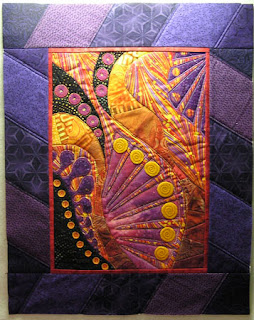My borders were on and I was getting ready to put on the binding. But as I was looking at it I felt that something wasn't quite right. As busy as this quilt is I felt that a limited amount of quilting was enough. Upon study of the finished product, however, I realized I was wrong!
As pictured here, the pieced segments on each side of my center segment were outline quilted. I determined that more quilting was needed in these segments to pull them to the background and give a little more detail for the eye to see. I also realized that the original stitching tension was poor which is always an issue for me! So I picked it out and quilted some more. . .. . .to get these results. The pieced segments are individually outlined which took them to the back and gave the eye something more to look at (not that I really needed more LOL). Now I could put the binding on.
And here's the finished product! I am very satisfied with it. I know that the majority of observers would not notice what I did. But in the end, as the creator, I am the one that has to be happy with it. What was going to take me one hour to finish took me four. But I will never be afraid to take the time to make my creation the best it can be, nor should you.






































